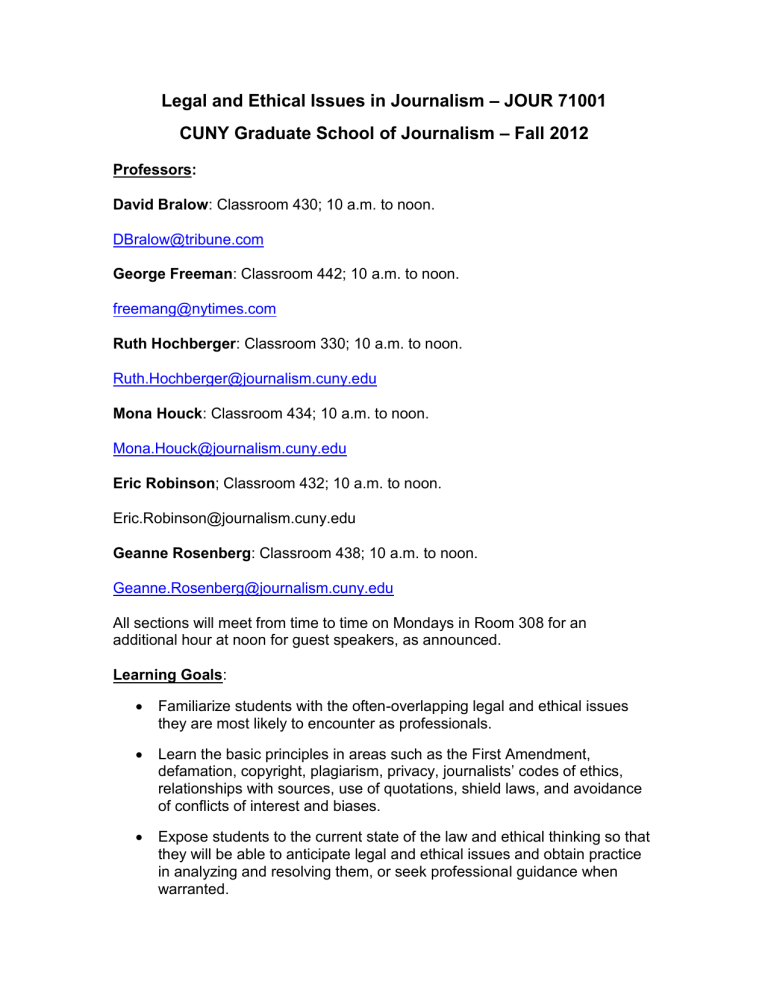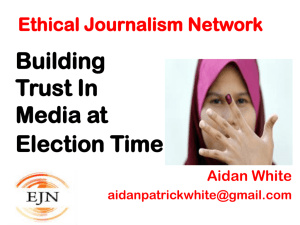Legal and Ethical Issues in Journalism – JOUR 71001 CUNY

Legal and Ethical Issues in Journalism – JOUR 71001
CUNY Graduate School of Journalism – Fall 2012
Professors:
David Bralow : Classroom 430; 10 a.m. to noon.
DBralow@tribune.com
George Freeman : Classroom 442; 10 a.m. to noon. freemang@nytimes.com
Ruth Hochberger : Classroom 330; 10 a.m. to noon.
Ruth.Hochberger@journalism.cuny.edu
Mona Houck : Classroom 434; 10 a.m. to noon.
Mona.Houck@journalism.cuny.edu
Eric Robinson ; Classroom 432; 10 a.m. to noon.
Eric.Robinson@journalism.cuny.edu
Geanne Rosenberg : Classroom 438; 10 a.m. to noon.
Geanne.Rosenberg@journalism.cuny.edu
All sections will meet from time to time on Mondays in Room 308 for an additional hour at noon for guest speakers, as announced.
Learning Goals :
Familiarize students with the often-overlapping legal and ethical issues they are most likely to encounter as professionals.
Learn the basic principles in areas such as the First Amendment, defamation, copyright, plagiarism, privacy, journalists’ codes of ethics, relationships with sources, use of quotations, shield laws, and avoidance of conflicts of interest and biases.
Expose students to the current state of the law and ethical thinking so that they will be able to anticipate legal and ethical issues and obtain practice in analyzing and resolving them, or seek professional guidance when warranted.
By dissecting case decisions and applicable legislation, and writing analyses of actual and hypothetical ethical situations, gain practice in weighing the competing ethical and legal principles so as to be able to apply them in their reporting, writing, video, audio, online and photographic assignments.
Address developments in the news during the semester, which provide subjects for immediate discussion, and relate them to concepts examined in the syllabus.
Syllabus:
This syllabus is designed to be flexible and is subject to change depending on the needs and interests of the individual seminar instructors, guest speaker availability, and questions and issues raised by students from their own reporting.
Requirements:
1. Attend all classes on time and prepared.
2. Participate in class discussions
3. Writing assignments: Assignments will include four two-page responses to case studies from the Knight Case Studies Initiative (available at https://casestudies.jrn.columbia.edu/casestudy/www/home.asp
), a Freedom of Information request, and a copyright registration application.
4. Midterm examination (Oct. 22)
5. Final examination (Dec. 17)
Grading:
Final grade will be based on:
1. Attendance, class preparation and participation: 20%
2. Midterm exam: 20%
3. Written assignments: 30% (due before beginning of following week’s class – no exceptions)
4. Final exam: 30%
Plagiarism:
It is a serious ethical violation to take any material created by another person and represent that it is your own original work. Any such plagiarism will result in serious disciplinary action, including possible dismissal from the CUNY J-School.
Plagiarism may involve copying text from a book or magazine without attributing the source, or lifting words, photographs, videos, or other materials from the
Internet and attempting to pass them off as your own. Student work may be analyzed electronically for plagiarized content. Please ask the instructor if you have any questions about how to distinguish between acceptable research and plagiarism.
Required Reading:
Assigned articles, court opinions and online readings.
Case studies from the Case Consortium @ Columbia (formerly, the Knight Case
Studies Initiative) for written assignments
( https://casestudies.jrn.columbia.edu/casestudy/www/home.asp
)
“Public Editor” column in the Sunday New York Times “Sunday Review” section
(basis for class discussion)
Assignments are listed under the date they are due.
Week One (Aug. 27): Introduction: Explanation of course, syllabus, requirements and case assignments. Discussion of journalism quality, legal and ethical best practices and pitfalls. Introduction to the Legal
System, Sources of Media Law; First Amendment; Audio and video releases.
Assignment: Make a list of five things reporters should never do. (NOT researched, from your own ideas). This will not be turned in or graded.
Read “Ask These 10 Questions to Make Good Ethical Decisions” by Bob Steele: http://www.poynter.org/latest-news/everyday-ethics/talk-about-ethics/1750/askthese-10-questions-to-make-good-ethical-decisions/
Sept. 3: Labor Day. NO CUNY CLASSES
Week Two (Sept. 10): Plagiarism, Fabrication, Copyright and Aggregation
Assignment:
Mini-research assignments on plagiarism and fabrication.
Poynter NewsU Media Law Copyright Online Module. Free registration available here: http://www.newsu.org/courses/online-media-law-basics-bloggers-andother-publish http://www.nytimes.com/2012/08/20/business/media/journalists-plagiarism-jonahlehrer-fareed-zakaria.html
“Correcting the Record; Times Reporter Who Resigned Leaves Long Trail of
Deception,” New York Times, May 11, 2003, http://www.nytimes.com/2003/05/11/us/correcting-the-record-times-reporter-whoresigned-leaves-long-trail-of-deception.html
“Editor’s Note” in the same issue, http://www.nytimes.com/2003/05/11/pageoneplus/11EDIT.html
“The Counter-Plagiarism Handbook,” Craig Silverman,
Columbia Journalism
Review, http://www.cjr.org/regret_the_error/the_counterplagiarism_handbook.php
Draft a copyright registration application for one of your articles, photos, or broadcasts (For assistance, http://www.copyright.gov/forms/ , and “Why and how to register your articles,” American Society of Journalists and Authors Contracts
Committee, http://www.asja.org/pubtips/copyrite.php
)
Sept. 17: NO CUNY CLASSES
Week Three (Sept. 24): Sources, Interviewing, Attribution and Using
Quotes. Subpoenas, shield laws and reporter’s privilege.
Assignment:
Read and brief Cohen v. Cowles Media Company.
Mini-research assignments on subpoenas and shield laws.
“Questions to Ask Before Going Off the Record,” Kelly McBride, http://www.poynter.org/uncategorized/25191/questions-to-ask-before-going-offthe-record/
New York Times Confidential News Sources Policy, http://www.nytco.com/company/business_units/sources.html
“Those Persistent Anonymous Sources,” Clark Hoyt, http://www.nytimes.com/2009/03/22/opinion/22pubed.html
“Tracking the Anonymice,” Jack Shafer, http://www.slate.com/id/2195078/ http://www.nytimes.com/2007/10/14/opinion/14pubed.html?ref=hoyt
Weeks Four and Five (Oct. 1 and Oct. 10): Defamation and Defenses and
Implications for Reporters, Editors and Publishers, including in reporting, editing and handling corrections and retractions.
(PLEASE NOTE: Oct. 8: No CUNY Classes, and Wednesday Oct. 10 CUNY follows a Monday Schedule)
Assignment:
Poynter NewsU Media Law Defamation Online Module. Free registration available here: http://www.newsu.org/courses/online-media-law-basicsbloggers-and-other-publish
Locate, read and brief: Milkovich v. Lorain Journal
Discussion Questions: What steps has the Supreme Court taken to ensure strong Constitutional protection for journalists? What are the key defenses to a defamation claim? What additional protections are provided by Section 230 of the Communications Decency Act? Why do some plaintiffs choose to bring defamation actions in jurisdictions outside of the United States?
Week Six (Oct. 15): Ethics Codes and Conflicts of Interest and Midterm
Review
Assignment:
“The New York Times Company Policy on Ethics in Journalism,” http://www.nytco.com/press/ethics.html
, Society of Professional Journalists Code of Ethics, http://www.spj.org/ethicscode.asp
, Radio Television Digital News
Association Code of Ethics and Professional Conduct, http://www.rtnda.org/pages/media_items/code-of-ethics-and-professionalconduct48.php
Watch or read the transcript of “Journalists as People,” Nov. 5, 2010, “On the
Media,” http://www.onthemedia.org/transcripts/2010/11/05/03
RTNDA Social Media and Blogging Guidelines, http://www.rtdna.org/pages/media_items/social-media-and-bloggingguidelines1915.php?g=37?id=1915
Carpenter v. United States , 282 U.S. 19 (1987)
R ead “Conflicted: The New York Times and the Bias Question,” and write no more than 2 pages on how you would decide and if you would publicly explain your decision.
Week Seven (Oct. 22): Midterm
Week Eight (Oct. 29): Access and Freedom of Information, Open Meetings and Courts
Regular Class will be followed by Guest Speaker Robert Freeman, director of New York’s Committee On Open Government, in 308 from 11:45 until 1 p.m.
Assignment:
Read: http://www.justice.gov/oip/referenceguide.htm
Prepare a 300 to 400 word Freedom of Information Act request for a proposed story (For help, see the Reporters Committee for Freedom of the Press “Federal
Open Government Guide,” http://www.rcfp.org/fogg/ ). Separately, list what possible exceptions or excuses the requested agency might rely on.
Week Nine (Nov. 5): Privacy: Legal and Ethical Issues
Assignment:
Poynter NewsU Media Law Privacy Online Module. Free registration available here: http://www.newsu.org/courses/online-media-law-basics-bloggers-andother-publish
“Name the Accuser and The Accused,” Geneva Overholser, http://www.poynter.org/archived/journalism-junction/13913/name-the-accuserand-the-accused/
“Respecting Privacy Guidelines,” Bob Steele, http://www.poynter.org/uncategorized/1837/respecting-privacy-guidelines/
“Think Before You Record,” Meg Martin http://www.poynter.org/uncategorized/70385/think-before-you-record/
Shulman v. Group W Productions Inc.
, 74 Cal.Rptr. 2d 843, 955 P.2d 469 (1998)
Read “On Downie’s Desk/Public Death, Private Life: Army Major Alan Rogers and The Washington Post.” Write no more than 2 pages as to what your decision would have been and why.
Week Ten (Nov. 12): Newsgathering Torts, Undercover Reporting and Fair
Tactics. Food Lion tape.
Assignment:
Poynter NewsU Newsgathering Liability Module.
Bartnicki v. Vopper.
Review Cohen v. Cowles Media Co. (previously assigned).
“Lying to Get the Truth,” Mark Lisheron, American Journalism Review,
October/November 2007, http://www.ajr.org/article.asp?id=4403
Week Eleven (Nov. 19): Community Standards: Offensive Material,
Language and Tone; Third-Party Posts and Comments Online
Assignment:
Listen to “What’s ‘Too Graphic’? How to Photograph Disaster,” “Talk of the
Nation,” Feb. 1, 2010, http://www.wbur.org/npr/123221099/whats-too-graphichow-to-photograph-disaster
“Images of Horror from Fallujah,” David D. Perlmutter and Lesa Hatley Major,
Summer 2004, http://www.nieman.harvard.edu/reportsitem.aspx?id=100834
Associated Press Standards and Practices: Obscenities, Profanities, Vulgarities, http://www.ap.org/newsvalues/index.html
“Dead Teen’s Photo Had Value Beyond Shock,” by Bill Mitchell, Aug. 25, 2002, http://www.poynter.org/uncategorized/2115/dead-teens-photo-had-value-beyondshock/
“Rejecting Racism: The Native Factor,” by Fanua Borodzicz, July 28, 2003, http://www.poynter.org/how-tos/newsgathering-storytelling/diversity-atwork/14071/rejecting-racism-the-native-factor/
Week Twelve (Nov. 26): Photography, Video, Audio and Skype: Special
Concerns
Assignment:
National Press Photographers Association Code of Ethics, http://www.poynter.org/how-tos/newsgathering-storytelling/diversity-atwork/14071/rejecting-racism-the-native-factor/
NPPA Digital Manipulation Code of Ethics, http://www.nppa.org/professional_development/business_practices/digitalethics.h
tml
“Photo Manipulation: A Lesson in Ethics,” by Nancy Wolff, Aug. 4, 2008, http://login.vnuemedia.com/pdn/content_display/resources/is-itlegal/e3i7c8f9d806fcefe2e4a8047b1258461af
“Why Is ‘Photo Illustration’ a Dirty Word in Journalism,” by Scott Baradell, June
22, 2008, http://rising.blackstar.com/why-is-photo-illustration-a-dirty-word-injournalism.html
, “The Case Against Photo Illustrations,” by Scott Baradell, June
23, 2008, http://rising.blackstar.com/why-is-photo-illustration-a-dirty-word-injournalism.html
Read “Worth a Thousand Words: The Associated Press and Lance Corporal
Joshua Bernard,” and write no more than 2 pages on what you would have done and why.
Week Thirteen (Dec. 3): National Security and News Reporting: From
Pentagon Papers to WikiLeaks. International Reporting Concerns.
Assignment:
Pentagon Papers Case. New York Times Co. v. United States
New York Times Answers to Readers’ Questions About State Secrets: http://www.nytimes.com/2010/11/29/world/29askthetimes.html?_r=1&pagewante d=all
Week Fourteen (Dec. 10): Reporter’s Role in Society: Duty to Report
Wrongdoing? Duty to Help Victims? Request to Cooperate With Law
Enforcement or Delay Story? Reporter’s Role as an Employee: How
Obligated Are You for the Success of Your Employer?
Assignment:
“SPJ Tells Journalists Not to Become Part of the Story,” http://www.poynter.org/latest-news/romenesko/100369/spj-tells-journalists-inhaiti-not-to-become-part-of-the-story/
“Reporters Doubling as Docs in Haiti,” Curtis Brainard, Columbia Journalism
Review, http://www.cjr.org/the_observatory/reporters_doubling_as_docs_in_1.php
“Western Reporters in Africa Struggle Over When to Help,” Abraham
McLaughlin, Christian Science Monitor, http://www.csmonitor.com/2006/0406/p01s03-woaf.html
“The Role of Journalism in the Midst of Disasters,” Mike Fancher, http://community.seattletimes.nwsource.com/archive/?date=20050925&slug=fanc her25
“Writer defends reporting Wie,” Tom Spousta, USA Today , http://www.usatoday.com/sports/golf/lpga/2005-10-17-wie-si_x.htm#
“Ethics of Paper’s Fake Arson Story Debated,” Sara Jean Green and Ian Ith,
Seattle Times, http://community.seattletimes.nwsource.com/archive/?date=20030418&slug=she rer18e
Assignment for next week: Study for Final Exam
Week Fifteen (Dec. 17:) Final Exam





